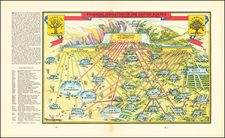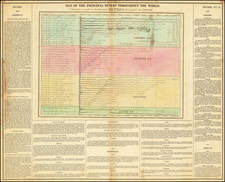A scarce example of Sanson's two-dimensional representation of an armillary sphere. Particular focus is given to lines of latitude on the globe. Other drawings and charts regarding celestial cartography are included. While the main focus of the map is not detailed topography or toponyms, it includes some noteworthy cartography: California as an Island, Korea as an Island, and a detailed and unusual rendering of Australia.
Armillary spheres, also known as spherical astrolabes and similar to celestial globes, were important early tools for astronomers. These are three-dimensional hollow objects with arcs representing the important celestial lines. This two-dimensional example includes many such lines. The projection on the left focuses on the effects from the sun. "Temperate" and "Frigid" zones are labeled, as well as the "solar great circles" along which the solstice occurs cotemporally, also known as lines of longitude. A great deal of attention is paid to the nature of the "sciens," from the Greek σκιά, meaning shadow. Those living near the equator are amphisciens, meaning their shadows point both north and south over the year. In addition, denizens of heterosciens, perisciens, and antoeciens regions are named. The sphere on the right explicitly labels latitudes and longitudes and the tropics. In addition, some diagonal lines are shown, of which the significance is unclear.
Other diagrams adorn this map as well. The signs of the zodiac are shown, as well as a windrose.
This map is a fascinating curiosity from the time following the Copernican Revolution.
Nicholas Sanson (1600-1667) is considered the father of French cartography in its golden age from the mid-seventeenth century to the mid-eighteenth. Over the course of his career he produced over 300 maps; they are known for their clean style and extensive research. Sanson was largely responsible for beginning the shift of cartographic production and excellence from Amsterdam to Paris in the later-seventeenth century.
Sanson was born in Abbeville in Picardy. He made his first map at age twenty, a wall map of ancient Gaul. Upon moving to Paris, he gained the attention of Cardinal Richelieu, who made an introduction of Sanson to King Louis XIII. This led to Sanson's tutoring of the king and the granting of the title ingenieur-geographe du roi.
His success can be chalked up to his geographic and research skills, but also to his partnership with Pierre Mariette. Early in his career, Sanson worked primarily with the publisher Melchior Tavernier. Mariette purchased Tavernier’s business in 1644. Sanson worked with Mariette until 1657, when the latter died. Mariette’s son, also Pierre, helped to publish the Cartes générales de toutes les parties du monde (1658), Sanson' atlas and the first French world atlas.









![[ The Ptolemaic Universe ] Situs Terrae Circulis Coelestibus Circundatae . . .](https://storage.googleapis.com/raremaps/img/small/101512.jpg)
![[ Equuleus ]](https://storage.googleapis.com/raremaps/img/small/83195.jpg)

![[17th Century Provenance!] Universalis Tabula Iuxta Ptolemaeum](https://storage.googleapis.com/raremaps/img/small/72635.jpg)
![[Pictish Man Holding Sword and Pike] Alterius viri Pictis vicini icon IIII](https://storage.googleapis.com/raremaps/img/small/99890.jpg)
